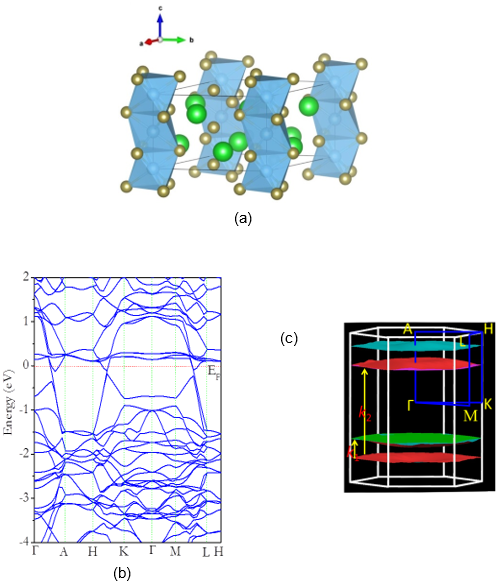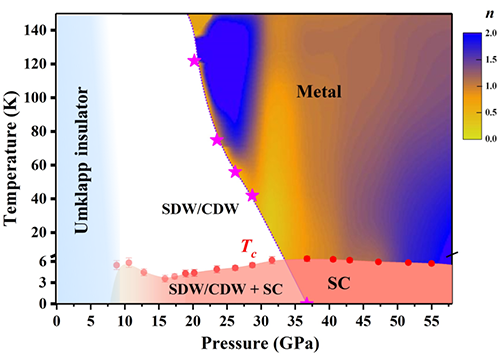Superconductivity with more: Putting pressure on one dimensional chains
Date:02-12-2019 Print
Atoms can form conducting chains that run through some crystalline solids. Electrical current flowing along these one dimensional (1D) chains is effectively limited to only a single dimension, which gives these solids quantum emergent properties and effects not seen in conventional three dimensional (3D) materials. The studies about the evolution from 1D conducting chains to 3D metal are even more interesting but mainly focused on organic quasi 1D conductors so far, such as (TMTTF)2X and (TMTSF)2X (X=TaF6, AsF6, PF6, ClO4). However, the researches are limited by their complex crystal structures.
Researchers from Professor Changqing Jin's team at the Institute of Physics, Chinese Academy of Sciences (IOPCAS)recently synthesized a new inorganic compound Ba3TiTe5 with simple quasi 1D structure. The compound can be recovered as a metastable structure at the ambient conditions. They further tune the quantum emergent properties of the new compound using synergetic high pressure techniques combined with low temperature & high magnetic field. They discovered series of quantum emergent phenomena including superconductivity (SC) induced by dimension crossover during the evolution from 1D to 3D like phase. (I) At ambient pressure, the band structure and Fermi surfaces of Ba3TiTe5 present typical 1D conducting features. However, the insulator behavior is observed at low pressure due to the Umklapp scattering effect. (II) When the effect of Umklapp scattering is completely suppressed by pressure, the first SC region associated with the instability of Luttinger liquid (LL) is observed. (III) Further increasing pressure, SDW/CDW transition is observed due to the Fermi surface nesting. The second SC is found to compete with the SDW/CDW. Its Tc increases as SDW/CDW is suppressed. At the quantum critical point where SDW/CDW is suppressed completely, Tc reaches its maximum ~ 6 K and the system displays non-Fermi liquid behavior. In a word, via pressure compressing quasi 1D Ba3TiTe5, profound quantum emergent phenomena including superconductivity are observed during the dimension evolution from 1D chain to 3D like metal.
This study entitled “A new quasi-one-dimensional compound Ba3TiTe5and superconductivity induced by pressure” was published on NPG Asia Materials 11, 60(2019). The paper is selected as a Feature Article of the journal. The study was supported by the National Science Foundation, the Ministry of Science and Technology of China.
 |
| Fig.1 (a) The crystal structure of Ba3TiTe5with a view of projection perpendicular to the c axis. (b) and (c) The calculated band structure and Fermi surfaces at ambient pressure, respectively (Image by IOPCAS) |
 |
| Fig. 2 (a) and (b) are the temperature dependence of resistance for Ba3TiTe5, measured as function of high pressure up to 58.5 GPa; (c) The superconducting transition as function of magnetic field at 17.3 GPa. (Image by IOPCAS) |
 |
| Fig. 3 The temperature pressure phase diagram of Ba3TiTe5showing interesting quantum emergent phenomena during dimension evolution from 1D chain (left) to 3D like metals (right). The red point denotes the superconducting temperatureTc, and the purple star is the MSC temperature Tm. In the metallic region, the color shading represents the value of exponentn= d(ln(R-R0))/d(ln(T)). (Image by IOPCAS) |
Contact:
Institute of Physics
Changqing JIN
Email:Jin@iphy.ac.cn
Key word:
Superconductivity; quasi one dimension; high pressure;
Abstract:
We report systematical studies of a new quasi-one-dimensional (1D) compound Ba3TiTe5 and the high-pressure induced superconductivity therein. Ba3TiTe5 was synthesized at high pressure and high temperature. It crystallizes into a hexagonal structure (P63/mcm), which consists of infinite face-sharing octahedral TiTe6 chains and Te chains along the c axis, exhibiting a strong 1D characteristic structure. The first-principles calculations demonstrate that Ba3TiTe5 is a well-defined 1D conductor and thus, it can be considered a starting point to explore the exotic physics induced by pressure via enhancing the interchain hopping to move the 1D conductor to a high dimensional metal. For Ba3TiTe5, high-pressure techniques were employed to study the emerging physics dependent on interchain hopping, such as the Umklapp scattering effect, spin/charge density wave (SDW/CDW), superconductivity and non-Fermi Liquid behavior. Finally, a complete phase diagram was plotted. The superconductivity emerges from 8.8 GPa, near which the Umklapp gap is mostly suppressed. Tc is enhanced and reaches the maximum ~6 K at about 36.7 GPa, where the spin/charge density wave (SDW/CDW) is completely suppressed, and a non-Fermi Liquid behavior appears. Our results suggest that the appearance of superconductivity is associated with the fluctuation due to the suppression of Umklapp gap and the enhancement of Tc is related with the fluctuation of the SDW/CDW.


